Company of Heroes 3 has changed a lot thanks to player feedback, from its interface to its major features
It's been over a year since I played the campaign, and now it's quite different.
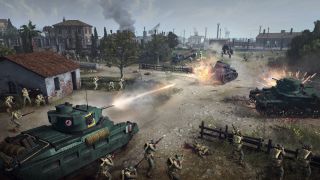
Between the alpha tests and my previews, I've played quite a bit of Company of Heroes 3 over the last year and a bit, so I wasn't expecting too many surprises when I popped down to London to check it out again, ahead of the February launch. But thanks to the large amount of feedback Relic has received from testers and its community council, it hasn't stopped tinkering, and there have been some notable changes as a result.
The most obvious one is the removal of controllable detachments. Given that they were one of the big new additions to Company of Heroes 3, it's a significant change. Detachments featured on the turn-based campaign map and could be used to heal other units or clear mines, among other handy abilities. They could also be attached to companies—which you send into the real-time battles—to augment them. A medic detachment, for instance, let you use a truck that passively healed nearby troops, and as an incredibly reckless commander I used this a lot when I dabbled in the campaign last year. My troops constantly needed medical attention.
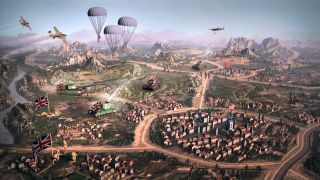
All the things you could do with detachments persist, but you no longer have a second type of unit to worry about. Instead, they're more like an upgrade that gives your companies more utility after they've been requisitioned from the company menu. This was, executive producer David Littman tells me, all down to player feedback.
"What we found was it was just a bit too much for players. It was getting a bit grindy having to move 20 different units every turn. So we still have all the special abilities that a detachment could do, but now they're more ingrained in the unit—you send them out to build a howitzer or you send them out to repair something, and they'll come back automatically. So just some ease of use there. All the balancing, all the tuning has been from our community council playing the game over the last few years."
Relic has made a lot of noise about how involved the fans are and how it embraces feedback, but that is increasingly the norm in this age of public alphas and early access. Often, though, this is merely a marketing initiative, but while Relic no doubt hoped that its demos would drive preorders, Company of Heroes 3 is a rare game that does feel like it's been shaped by its community.
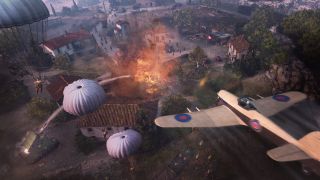
The feedback regarding detachments came in a survey in July 2021. "Right there and then, we knew," Littman says. "We were like 'Where there's smoke, there's fire.' We were starting to see people not enjoying themselves."
The star of our show is still the RTS, but the strategic map still has to have depth to it and strategy behind it.
David Littman, Relic
While the change was settled on a year ago, only now have I been able to see the impact on the campaign. I actually liked the micro-management wrinkles the detachments created, and found their flexibility made the cost worthwhile, but I can't deny that the campaign feels a lot smoother now that they've been bundled into companies. And since all the tactical choices they opened up remain, it doesn't feel like anything is missing.
The biggest gaming news, reviews and hardware deals
Keep up to date with the most important stories and the best deals, as picked by the PC Gamer team.
What Relic didn't want to do was risk the campaign's depth. "We want players who love Unity of Command and who love Panzer General to come here and have fun," says Littman. "We want them to see that the depth is there from those other strategy games. Now the star of our show is still the RTS, but the strategic map still has to have depth to it and strategy behind it."
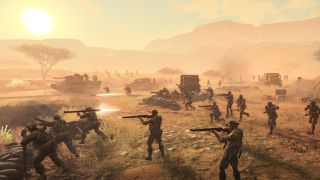
It's been a learning experience for a studio that is best known for real-time strategy. Even though it has dabbled in turn-based campaigns before, like in the smaller, dynamic campaigns of Dawn of War and Ardennes Assault, Company of Heroes 3's Italian campaign is a very different beast, with shades of both Total War and grognardy war games.
With the latter comes added complexity through features like supply lines—you can't expect soldiers to win a war when they're starving, out of ammo and none of their vehicles work—but it's taken time for Relic to figure out how to make these things work. Supply lines didn't really come together "until recently", Littman notes, but now the team has built a system that it feels is easy to use.
"The Italian map is so big. There are so many territories: 150 capture points and cities and towns and airports and seaports. Having a supply line that you had to keep moving up roads was just impossible for a player to keep track of. So now we have about 15 supply hubs across the map. And you and the Germans fight over them."
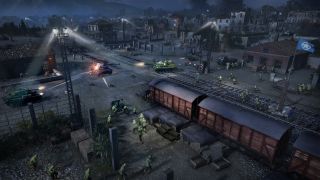
Keeping hold of these hubs is vitally important. If you have more than the Germans, that means you have more movement points, and the caps on your ammo and manpower will be bumped up. "You really can't win the war unless you have the supply hubs," says Littman. "You just won't have enough resources to do all the things you need to do."
You really can't win the war unless you have the supply hubs.
David Littman, Relic
It seems like it should be a great source of friction—another objective to fight over instead of aimlessly painting the map. And it opens the door to new strategies, like cutting the enemy off from their supplies to force them to rout. And if you hold most of the hubs, the enemy can only stay in your territory for a couple of turns before they start running low on supplies and have to leg it back to their own territory. Of course, you can still surround them before that happens and wipe them out. Systems that are "simple to use, but still have a big impact" is the goal, says Littman.
The UI has also been given a rework to improve its clarity, with Relic putting each change in front of players first, until they finally got to a place where there was a consensus. "We relied on players to tell us how they wanted to play the game," says Littman, who admits that it was "really hard to get right".
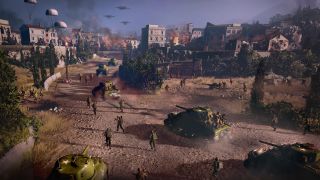
And then there have been the aesthetic tweaks—just as important in a game that has this much spectacle. Players felt that Italy was just a bit too bright and vibrant for a country at war. The Mediterranean theatre is brighter and more colourful than, say, Normandy, and these maps take an absolute beating over the course of a battle, transforming towns into grim ruins and fields into pockmarked wastelands, but after listening to players Relic decided to emphasise the impact of war even more. And it's not just the state of the maps after the fighting starts, but the grime and battle damage present on units, too. Everything just looks a bit more bleak.
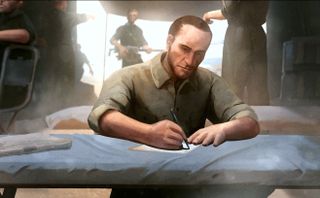
The new MVP: Don't sleep on the brilliant recovery vehicles
North African operation: A deep dive into Company of Heroes 3's second campaign
Multiplayer mayhem: Hands-on with the chaotic but incredibly fun multiplayer
Thanks to its cultural consultants, Relic's also changed one of the subcommanders—characters who serve as advisors, and who you can build relationships with by taking said advice, unlocking handy new bonuses. As well as an American and British representative, the Italian partisans also have a voice. Initially this was provided by a member of the Allied forces, but having a liaison isn't quite the same as having one of the partisans on your team. She's now been replaced by Valenti, an Italian with a vested interest in liberating Italy. It's a small change, but one that avoids minimising the partisans' role.
The relationships you develop with your subcommanders are unexpectedly evocative of RPGs like Mass Effect. They will suggest drastically different approaches and squabble about what path you should take, so you really get to feel like you're the head of a team that has some agency. And while your subcommanders don't gain experience, the closer you become to them, the more of their tree you unlock. So if you focus on Valenti, you're going to have a lot more tools to make the partisans more effective. Each of them has a speciality that you can take advantage of, but you won't be able to unlock everything in a single campaign.
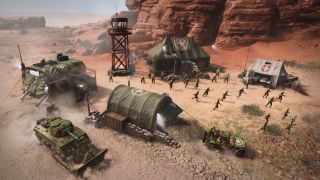
RPG vibes can also be seen in the company skill trees, which is another place where player feedback has been important. Players wanted it to be a bit more like Total War, where the leader of an army really defines its role, letting you create specialists by selecting specific abilities and bonuses when they level up. The reworked skill trees don't entirely ape Total War's, but the philosophy is certainly similar, letting you now mould a company into a fighting force that fits your playstyle or focuses on specific tactics. "It started to become a little bit more like an RPG," says Littman. "And that's when it really started feeling good."
It started to become a little bit more like an RPG. And that's when it really started feeling good.
David Littman, Relic
After my first glimpse of the prologue, I only had six turns with the Italian campaign, which isn't much time to dig into the large number of changes. It's more than it sounds, though. Within those six turns I managed to do a lot, taking over several settlements and an airfield, splitting my time between RTS combat and campaign management. The first time I tried the campaign, back in 2021, I stayed up all night and played for something like 11 hours straight, so clearly I was having a good time before all these changes were introduced, but it absolutely feels tighter this time around. I was making fewer moves, but each had a greater impact.
It's worth noting, too, that while Relic has streamlined some systems, others have been enhanced. AI, for instance, is considerably more aggressive, and there are generally more hurdles in the way of your liberation of Italy. My navy, which was ridiculously effective last year, is no longer the secret weapon it once was. Before, there was no counter to my coastal bombardments or my ability to ignore enemy fortifications by just dropping troops on a beach behind enemy lines, but now there are risks, like the Luftwaffe bombing your precious vessels.
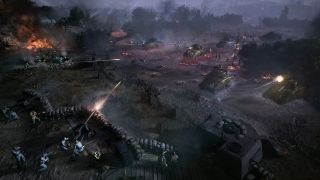
The result, I hope, will be more of a back-and-forth conflict, forcing both players and the AI to adapt and reconsider their plans as borders shift and airfields and seaports aggressively change hands. Just enough so you think "OK, if I don't come up with a good strategy I might lose this war."
You'll be able to see these changes for yourself when Company of Heroes 3 launches on February 23, but before that there's one more chance to play early. Unfortunately you won't be dipping into the campaign again, but if you've been itching for more multiplayer brawls, you should be content. This multiplayer test will primarily be a stress test, making sure that Relic's servers can handle a lot of players, but Littman says it should also be a good place for new players, who haven't experienced the other demos, to see if this is the game for them. From everything I've seen so far, it's certainly shaping up to be the game for me.

Fraser is the UK online editor and has actually met The Internet in person. With over a decade of experience, he's been around the block a few times, serving as a freelancer, news editor and prolific reviewer. Strategy games have been a 30-year-long obsession, from tiny RTSs to sprawling political sims, and he never turns down the chance to rave about Total War or Crusader Kings. He's also been known to set up shop in the latest MMO and likes to wind down with an endlessly deep, systemic RPG. These days, when he's not editing, he can usually be found writing features that are 1,000 words too long or talking about his dog.
Most Popular

